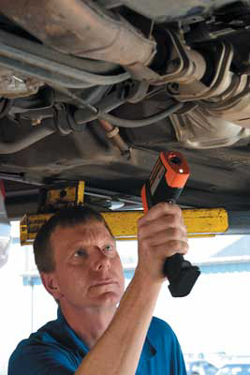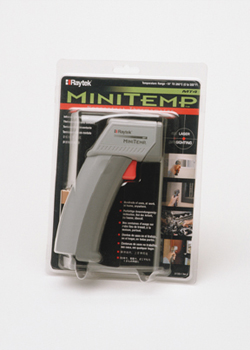 |
We test some high-tech
helpers.
by Hib Halverson
©1998 by Shark Communications
updated April 2004
No Use Without Permission
|
Recently, at the request of the Idaho Corvette web site, I tried out five technology-filled products that make diagnostic, maintenance, or modification of our cars easier. Products covered were either evaluated specifically for this article or had been used by myself for some some time prior to this story. Auto Meter Battery Extender Auto Meter Battery Extender You may own Corvettes that are parked or stored for long periods. If you do, occasionally, you've probably had a dead battery. Even the best battery connected to nothing slowly discharges because of the chemical processes at work inside it. Once hooked to your car's electrical system and when the alternator is not charging, besides that tiny, self-discharge rate, a battery has a 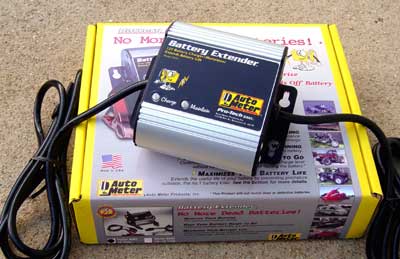 small, constant load on it from things like: PCM memory, radio presets,
clock, anti-theft devices and, if you open the doors while the car sits,
interior lighting. If a period of non-operation is a few months, it is
possible the battery may discharge to the point of a no-start condition.
Then, you either charge the battery or jump-start the car. These
full-discharge-then-recharge or "deep cycles" reduce battery life. The
durability of typical automotive batteries is significantly reduced if
they're subjected to deep cycles on a regular basis. The old solution
was to leave a "trickle" charger connected to the battery. Most trickle
chargers put out between 0.5 to 2 amps. Indeed, that charges the
battery, but trickle chargers do as much harm as good. Once the battery
is at full charge; a continuing 0.5-2 amp charge eventually overcharges
it. That can damage a battery just as much as successive deep cycles.
The solution is a "smart" battery charger, such as Auto Meter's Battery
Extender. Upon connection, if the battery is partially discharged, a
Battery Extender brings a battery up to full charge using a one-amp
rate. At that point, a microprocessor senses battery voltage at a
nominal level and backs-off the charge rate to between 0 and 250
milliamps, depending on load. This feeback-controlled, reduced charge
rate eliminates overcharging and extends battery life. There is no need
to monitor a Battery Extender. Just plug it in, connect it to the car
and forget it. Auto Meter makes two versions of the Extender, a 12-volt
unit (p/n 9201) and a 12/16-volt unit (p/n 9202) aimed at racers using
16-volt electrical systems. The original Battery Extender was introduced
by AutoMeter in 1999. It was upgraded a year later with a battery
condition test feature which flashes the unit's charge light if it
detects a dead battery cell or if it detects that the battery is
sulfated. We have four cars in the shop which are inoperative for long
periods. We used to regularly have dead batteries and, occasionally, the
inevitable battery failure due to deep cycles. Putting Battery Extenders
on each of these cars has eliminated those problems. This inexpensive
device is on our must-have list. For more information, contact Auto
Meter at 413 W. Elm St., Sycamore IL 60178, web:
www.autometer.com
, tel: 815-895-8141.Vetronix Mastertech
small, constant load on it from things like: PCM memory, radio presets,
clock, anti-theft devices and, if you open the doors while the car sits,
interior lighting. If a period of non-operation is a few months, it is
possible the battery may discharge to the point of a no-start condition.
Then, you either charge the battery or jump-start the car. These
full-discharge-then-recharge or "deep cycles" reduce battery life. The
durability of typical automotive batteries is significantly reduced if
they're subjected to deep cycles on a regular basis. The old solution
was to leave a "trickle" charger connected to the battery. Most trickle
chargers put out between 0.5 to 2 amps. Indeed, that charges the
battery, but trickle chargers do as much harm as good. Once the battery
is at full charge; a continuing 0.5-2 amp charge eventually overcharges
it. That can damage a battery just as much as successive deep cycles.
The solution is a "smart" battery charger, such as Auto Meter's Battery
Extender. Upon connection, if the battery is partially discharged, a
Battery Extender brings a battery up to full charge using a one-amp
rate. At that point, a microprocessor senses battery voltage at a
nominal level and backs-off the charge rate to between 0 and 250
milliamps, depending on load. This feeback-controlled, reduced charge
rate eliminates overcharging and extends battery life. There is no need
to monitor a Battery Extender. Just plug it in, connect it to the car
and forget it. Auto Meter makes two versions of the Extender, a 12-volt
unit (p/n 9201) and a 12/16-volt unit (p/n 9202) aimed at racers using
16-volt electrical systems. The original Battery Extender was introduced
by AutoMeter in 1999. It was upgraded a year later with a battery
condition test feature which flashes the unit's charge light if it
detects a dead battery cell or if it detects that the battery is
sulfated. We have four cars in the shop which are inoperative for long
periods. We used to regularly have dead batteries and, occasionally, the
inevitable battery failure due to deep cycles. Putting Battery Extenders
on each of these cars has eliminated those problems. This inexpensive
device is on our must-have list. For more information, contact Auto
Meter at 413 W. Elm St., Sycamore IL 60178, web:
www.autometer.com
, tel: 815-895-8141.Vetronix Mastertech
Mastertech is best described as: TECH-1, only more so. While it shares the basics that made the T1 a great device; its improvements make it an even more powerful, hand-held diagnostic computer. Like other Vetronix equipment, itís built to tough, dealer service standards. Its 3-in LCD display shows either 16-lines of user-selectable data in the list or snapshot modes, six data parameters in the bar graph mode or two in the line graph mode. The unit has eight LEDs that can be configured to show discrete data such as closed/open loop, rich/lean flags, HVAC requests or shift switch condition. Mastertech also has limited digital meter functions: voltage, duty-cycle and frequency. It has an oscilloscope mode that can display waveforms typical of MAF, MAP and oxygen sensors or any other waveform with an amplitude of 20 volts or less. With the addition of an optional, "enhanced diagnostic lead set", the oscilloscope mode can be used in high-voltage situations. With EDLS, Mastertech directly displays waveforms up to 600v and though an inductive pick-up, can graphically display spark plug voltage levels. The Mastertech even has "on-line" help. Rather than rummaging around for the manual, basic questions on operation can usually be found by simply pressing the "help" key. Vetronix has Mastertech software for the powertrain, chassis or body computers in all í81-í96 GM cars and trucks that have computers and í97 and í98 are only partially supported. Weíve used a Mastertech for several years, not only for diagnostic purposes, but also as a data logger during chassis dyno tests. Itís performed very well in both roles. If youíre starting a high-end, diagnostic tool box; consider the Mastertech. Itís leading-edge stuff and one of the more advanced scan testers on the market at this writing. DIYs can buy the Mastertech though Mac Tools. For more information, contact a Mac Tools dealer or the Vetronix Corporation, 2030 Alameda Padre Sierra, Santa Barbara, CA 93103, (800) 321-4889, www.vetronix.com. MSD Ignition Tester This handy device tests MSD ignition amplifiers as well as those of other manufacturers. It is no more than an adjustable signal generator that substitutes for whatever triggers your ignition. It saves time in  troubleshooting and by assisting in decisive diagnosis.
troubleshooting and by assisting in decisive diagnosis.
To use the MSD Tester simply connect its power leads to the carís battery and its white wire to either the magnetic trigger, positive input (a violet wire or a connection marked M+) or the white wire input of the MSD. If the ignition amp is not an MSD, but uses a magnetic trigger; find the magnetic trigger positive input and connect the Testerís white wire to that. A special testing spark plug is included with the unit. Clip that to a good ground and connect the distributor end of the coil wire to it. Select the number of cylinders with the switch on the tester, turn on the carís ignition then vary the testing rpm with the thumbwheels on the side of the tester. Recently, using this device, I troubleshoot a car with intermittent no-start and ignition cut-out problems. The process quickly showed the carís six-year-old, MSD 6T was the problem. The unit had been subjected to street high-performance/racing duty cycle for nearly 40,000 miles, reasonable durability for an ignition product used that way. I sent it to MSD and, in spite of it being out of warranty, two weeks later it came back repaired for just the cost of the shipping. The MSD Ignition Tester can be used to diagnose many ignition related problems. For more information, contact the Autotronic Controls, Corp., 1490 Henry Brennan Dr., El Paso TX 79936, (915) 857-5200, www.msdignition.com.
You can assess the condition of universal or constant velocity joints with an IR thermometer. Drive the car for a while, then park and measure the temperature of the u-joints or CVs. If you have a joint thatís running at a noticeably higher temperature than the others, thatís a clue that joint may have a problem.
Until late 2002, Raytek marketed itís general purpose ST series to advanced automotive DIYs and the service trade, however, in several years of selling these tools to the automotive market, sales volume grew to the point where an automotive-specific product was justified. The Autopro combines many of the core features of the ST series with specialized enhancements such as a dual-beam laser sight designed to make IR thermometer use more convenient in the automotive environment. A white LED which comes on when the trigger is pulled to illuminate the measuring area. Bright orange trim to make the Autopro easy to find on a crowded work bench. A removable magnet that attaches to the bottom of the handle such that you can stick the device on the side of your tool box or to a metal work bench when itís not in use. All of these features plus the accuracy and quality Iíve come to expect from Raytek products have made the Autopro a favorite of mine. Iíve used it for a wide variety of Corvette service tasks, some of which are listed above. The MiniTemp is a smaller, less expensive and slightly less-capable IR Thermometer. While Iíve used a MiniTemp for some automotive tasks, Iíve also used it for "mission critical," non-automotive purposes like verifying the beer in my cooler is adequately chilled or measuring the temperature of a steak on the barbecue out back of the shop.
The Vericom VC-2000 Performance Computer The 1986 introduction of the Vericom VC-200 was a milestone. It made affordable, portable and accurate vehicle dynamics testing available to enthusiasts. Of the products evaluated for this article, the one weíve used the longest is the Vericom Performance Computer. That makes a pretty strong statement about the reliability and durability of Vericom products. After Iíd used a VC-200 for 12 years in countless vehicle tests, the people at Vericom suggested I upgrade to the new VC-2000. While Vericomís basic featuresĖeasy-to-read display, convenient interface, lighted key pad and stable four-point mountingĖcarried over to the new VC-2000; there is significant improvement, also. The first thing I noticed is a 40-character, LCD, dot-matrix display that shows two and a half times more data and is easier to see in bright light. Our trusty VC-200 provides test data for one, specific distance. That means lots of testing if I want quarter-mile info, a 60-foot time and 0-60 mph data. The VC-2000 gives that and more. In the acceleration mode, it displays time, speed, acceleration rate and net horsepower at 15 ft., 30 ft., 60 ft., 330 ft., 1/8 mi., 1000 ft. and 1/4 mile. They also read time, distance and acceleration rate for 0-30 mph and 0-60 mph. Increased data per test is the biggest advantage I saw in upgrading. The VC-2000 is available in five models, three aimed at DIY enthusiasts and racers and two more, higher-priced units, aimed at vehicle development engineers and other professionals. All use Vericomís patented, highly-accurate capacitance accelerometer coupled with a crystal-controlled clock and a microprocessor. All that makes a basic inertial navigation system. More complex versions are used in aircraft. A principle of inertial navigation is: if you know the rate an object accelerates, the objectís mass, when the acceleration started and the time elapsed during the acceleration, you can compute how fast that something went, how far it went, how long it took to get there and how much energy was expended to get it there. That is what a Vericom Performance Computer does. The best value is the entry-level, "VC-2000 Race". It delivers all basic features and lists at $527.00, a heck of a bargain considering, 12 years ago, the VC-200 sold for 400 bucks. This piece of equipment meets the testing needs of most enthusiasts and racers competing with production-based cars. The next step is the "Race Plus" which adds battery power. All Vericoms run of a carís cigar lighter, however, the VC-2000 Race and other uplevel units also have internal batteries. Battery power is handy when the 12-volt socket is used by other devices and it allows the Vericom to be used in cars without lighter or accessory sockets. The uplevel Vericoms have extra RF interference shielding needed when magneto ignitions or solid core plug wires are used. The top-of-the-line Race unit adds a tachometer input allowing display of rpm and net torque output. The VC-2000 Professional Series models have significantly more computer power giving them on-board data storage for up to 98 test runs and the ability to communicate with personal computers over an RS232 communications link. They also have a connection for any switched, 12-36 volt input to trigger the unit. VC-2000 Pros come with "VC Profile", a software application that runs on a PC using either Windows 3.1 or 95. VC Profile increases the power of a Vericom as a vehicle testing tool by assisting the user in organizing, analyzing and comparing data. It can save data to disk. VC Profile has numerous other data management and analysis abilities. A common Vericom question is, "How accurate is it?" Compared to conventional timing, I find itís almost always within 0.1 second. The VC-200 I used for so long did not allow change of the trigger acceleration threshold, however, a VC-2000 does. I have not used the new unit long enough to establish a trend, but I believe, when the threshold is reduced from the 0.2g default to 0.1g; accuracy may improve to less than Ī0.1 sec. Compared to drag strip clocks, one factor a Vericom canít consider is "roll out", the distance between the point at which the car starts to move and the point at which the clocks are started by the carís front wheels. Because of this, a Vericom reads a longer time but almost the same speed. Roll-out varies with front tire diameter, how hard the car leaves and whether itís deep- or shallow-staged, but usually itís between 0.2-0.4 seconds. The VC-2000 instruction manual has a detailed discussion of roll out along with an explanation of how to figure roll-out time. Anyone needing comprehensive test data about the performance of their car, needs a Vericom. For more information on the VC-2000 Performance Computers, contact Vericom Computers, Inc., 6008 Culligan Wy., Minnetonka, MN 55345. (612) 933-4256., vericom@vericom.org . also, www.vericom.org.
|
Return To Technical Page
Return To Corvette Articles
The Web Surfers Guide To Diagnostic Equipment
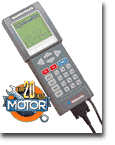 The
Vetronix Corporation is the Santa Barbara, California firm that
developed the TECH1 scan tester for GM in the mid-í80s. The TECH1A is
still sold by Vetronix and about 45,000 of them are in service
world-wide. The T1ís success enhanced Vetronixís reputation in the
diagnostic equipment industry such that, in the early-í90s, the U.S.
arms of a couple of big Asian manufacturers came looking for specific,
high-end scan testers for their dealer service organizations. Later,
Vetronix rolled that platform into a generic high-end tester and called
it "Mastertech".
The
Vetronix Corporation is the Santa Barbara, California firm that
developed the TECH1 scan tester for GM in the mid-í80s. The TECH1A is
still sold by Vetronix and about 45,000 of them are in service
world-wide. The T1ís success enhanced Vetronixís reputation in the
diagnostic equipment industry such that, in the early-í90s, the U.S.
arms of a couple of big Asian manufacturers came looking for specific,
high-end scan testers for their dealer service organizations. Later,
Vetronix rolled that platform into a generic high-end tester and called
it "Mastertech".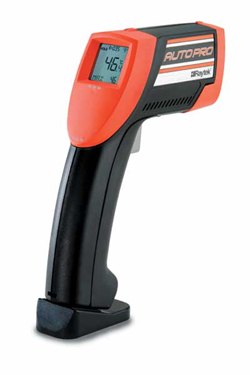
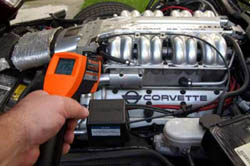 There are many uses for a Raytek. Have an engine with a hard-to-find misfire? Point the tool at each exhaust port. If you find one thatís significantly cooler than the others, thatís your cylinder with the miss. You can check fuel distribution the same way, only you look for more subtle temperatures differences. Got one port thatís a little hotter than all the others? Thatís a clue that cylinder is running a bit lean. How about a catalytic converter whose operation is suspect? By measuring the inlet and outlet temperatures, you can determine if the cat is working or not.
There are many uses for a Raytek. Have an engine with a hard-to-find misfire? Point the tool at each exhaust port. If you find one thatís significantly cooler than the others, thatís your cylinder with the miss. You can check fuel distribution the same way, only you look for more subtle temperatures differences. Got one port thatís a little hotter than all the others? Thatís a clue that cylinder is running a bit lean. How about a catalytic converter whose operation is suspect? By measuring the inlet and outlet temperatures, you can determine if the cat is working or not.